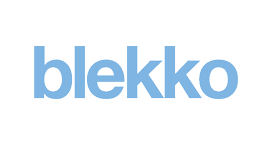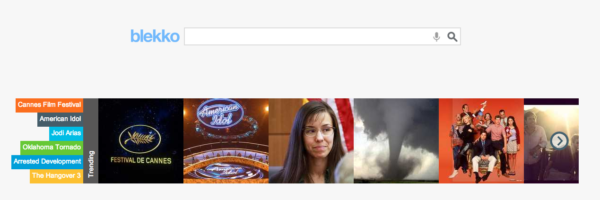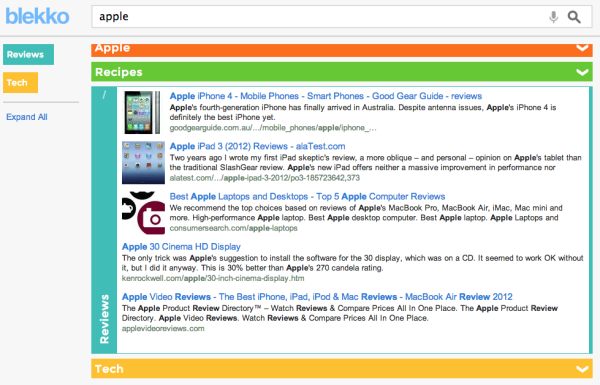Seeking Broader Appeal Blekko Offers Bold New UI
In January, upstart search engine Blekko launched a specialized tablet app called Izik. The UI and overall experience were optimized for the touch-screen devices. Search results were more visual and finger friendly. Most of all, CEO Rich Skrenta stressed that Izik was leaving behind the familiar “10 blue links.” As part of the Izik launch, […]
 In January, upstart search engine Blekko launched a specialized tablet app called Izik. The UI and overall experience were optimized for the touch-screen devices. Search results were more visual and finger friendly. Most of all, CEO Rich Skrenta stressed that Izik was leaving behind the familiar “10 blue links.” As part of the Izik launch, Blekko built an API.
In January, upstart search engine Blekko launched a specialized tablet app called Izik. The UI and overall experience were optimized for the touch-screen devices. Search results were more visual and finger friendly. Most of all, CEO Rich Skrenta stressed that Izik was leaving behind the familiar “10 blue links.” As part of the Izik launch, Blekko built an API.
Now that API, together with Blekko’s corpus of curated search categories (slashtags), form the infrastructure behind a new Izik-inspired design for the main Blekko site. This morning, Blekko is introducing a bold redesign that puts more content on a single page even as it makes the page easier to navigate.

The “old Blekko” had a more or less conventional search UI and link-centric results (immediately below). The new Blekko is much more “visual” and also uses responsive design.
Results on the new Blekko are organized into visually labeled, multi-colored categories that make it easier to quickly find the type of information being sought. This is perhaps most effective with ambiguous queries such as “Apple,” “Tesla” or “Diabetes.”
Each category can be expanded, allowing users to scroll horizontally through many more pages of results. This action is akin to users on a tablet flipping through many pages of information quickly.
This expanded-category approach enables Blekko to pack much more information into a single page of search results. Indeed, each category is effectively a SERP with potentially hundreds of results. What Blekko has effectively done is execute multiple searches and organized them on a single page to free the user from having to refine and search several times to obtain the desired information.
For comparison, below is Google’s current search results page for “Apple”:
If you compare Izik’s UI with the new Blekko you can see where the design changes came from. With this new aesthetic Blekko hopes to appeal to a broader spectrum of users.
Currently the site has roughly 12.5 million users conducting approximately five million daily searches. Blekko has raised roughly $53 million to date, including $30 million from Russian search engine Yandex.
One of the major selling points of Blekko — indeed its mission — is to create an index that is essentially free of “spam” (here defined broadly to include low-quality sites). Human editors and third-party expert curators have identified authoritative and high-quality sites in most of the major categories. Those form the basis of Blekko’s results. It’s truly a hybrid person-machine approach.
Here’s how Blekko describes what it does:
Blekko’s proprietary technology operates on a unique system that intersects our own original search index, Dynamic Inference Graph (DIG) algorithm, and editorial evaluation. Using the text from the Web stored in our datacenter, we distill the text and links down to a small semantic database, and use that database to map queries to a large list of editorially-crafted slashtags.
Blekko CEO Skrenta and I spoke about how mobile and tablet UI design in particular is influencing PC site design. There are numerous examples of this, including at Google. But while the Blekko redesign is much more than a cosmetic revamp that’s how most users will experience it.
It’s not clear to me whether the new UI will seem “different enough” to attract significant new usage. However, the company has the “runway” to continue experimenting and can afford to build its audience over time.
Contributing authors are invited to create content for Search Engine Land and are chosen for their expertise and contribution to the search community. Our contributors work under the oversight of the editorial staff and contributions are checked for quality and relevance to our readers. The opinions they express are their own.
Related stories
New on Search Engine Land




